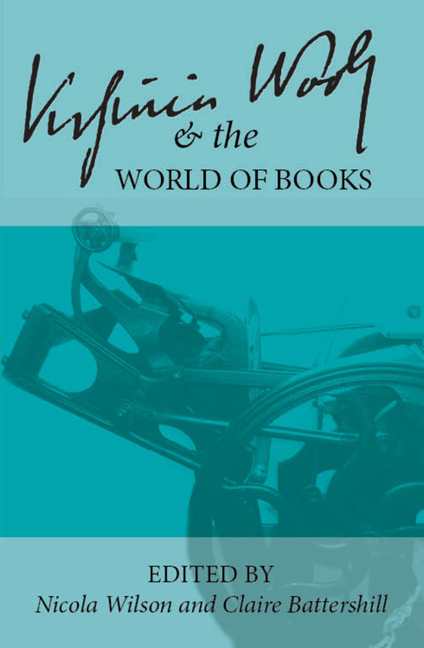 Virginia Woolf and the World of Books
Virginia Woolf and the World of Books Book contents
- Frontmatter
- Contents
- Introduction
- List of Abbreviations
- Keynote
- In the Archives
- Craftsmanship
- “Wood is a pleasant thing to think about”: William Blake and the Hand-Printed Books of the Hogarth Press
- Virginia Woolf, the Hogarth Press, and “Short Things”
- “Scarcely a Brick to Be Seen”: Breaking Boundaries in “Kew Gardens” and “The Mark on the Wall”
- Virginia Woolf's Arts and Craftsmanship
- The Hogarth Press
- Hours in A Library
- The Art of the Book
- The Art of the Narrative
- Making New Books: Creative Approaches
- The Book in the World: Woolf's Global Reception
- Editing and Teaching Woolf
- Intertextuality
- Lives in Writing
- Notes on Contributors
Virginia Woolf's Arts and Craftsmanship
from Craftsmanship
- Frontmatter
- Contents
- Introduction
- List of Abbreviations
- Keynote
- In the Archives
- Craftsmanship
- “Wood is a pleasant thing to think about”: William Blake and the Hand-Printed Books of the Hogarth Press
- Virginia Woolf, the Hogarth Press, and “Short Things”
- “Scarcely a Brick to Be Seen”: Breaking Boundaries in “Kew Gardens” and “The Mark on the Wall”
- Virginia Woolf's Arts and Craftsmanship
- The Hogarth Press
- Hours in A Library
- The Art of the Book
- The Art of the Narrative
- Making New Books: Creative Approaches
- The Book in the World: Woolf's Global Reception
- Editing and Teaching Woolf
- Intertextuality
- Lives in Writing
- Notes on Contributors
Summary
Virginia Woolf begins her 1937 radio broadcast, “Craftsmanship” with a curious sleight of hand, seeming to reject the title which was allotted to her by the BBC even as she draws attention to it. “There is something,” she says, “incongruous, unfitting, about the term ‘craftsmanship’ when applied to words” (CDML 137). Woolf proposes changing the title to “A Ramble round Words, perhaps” (137) but in this she equivocates, so ultimately the talk is both rendered title-less, or, in her words “decapitated,” and haunted by multiple possible titles. Woolf thus begins the essay by strategically engaging with and distancing herself from “craftsmanship” in ways that set the stage for and shape a playful argument about the usefulness of language.
In an essay about the associative, suggestive, and communal function of language, “craftsmanship” is the first word of which Woolf considers the etymology and significance. With reference to the English Dictionary, she tells us that “craft” has two meanings: “in the first place making useful objects out of solid matter—for example, a pot, a chair, a table.” And “in the second place…cajolery, cunning, deceit” (137). While Woolf seems to dismiss “craftsmanship” as irrelevant to her argument about words, noting with ambiguous irony that “words never make anything that is useful; and words are the only things that tell the truth,” she then uses them to conjure up two strikingly visceral images—words “mate” to become a “monster fit for a glass cage” and words become a headless hen running “round in a circle til it drops dead” (137). It is thus curiously fitting to Woolf 's argument about language that craft evokes both the material (“a pot, a chair, a table”) and the immaterial (“cajolery, cunning, deceit”). Despite seeming to dismiss “craftsmanship” as insignificant to her argument about words, Woolf considers the word judiciously and playfully (or we might even say, “craftily”). Craft, in both noun and verb forms, becomes a nexus point for an entanglement of ideas around making, creating, and producing.
In his 1968 book, The Nature and Art of Workmanship, David Pye asserts that craftsmanship is “a word to start an argument with” (341).
- Type
- Chapter
- Information
- Virginia Woolf and the World of BooksSelected Papers from the Twenty-seventh Annual International Conference on Virginia Woolf, pp. 62 - 68Publisher: Liverpool University PressPrint publication year: 2018


